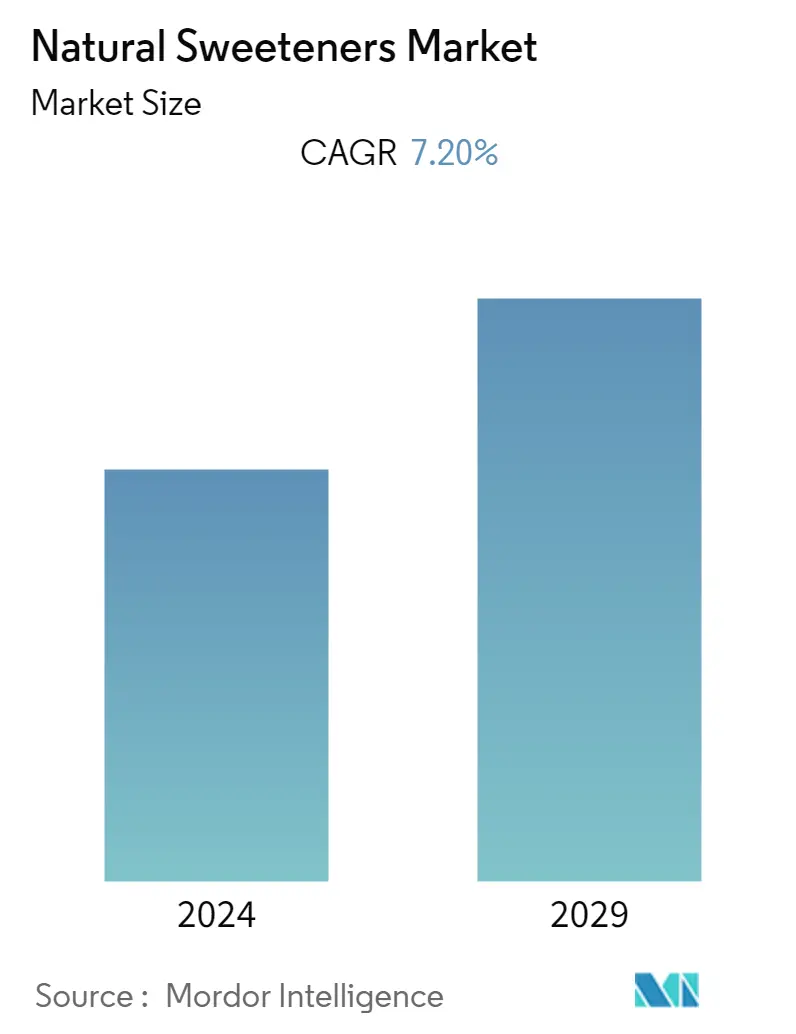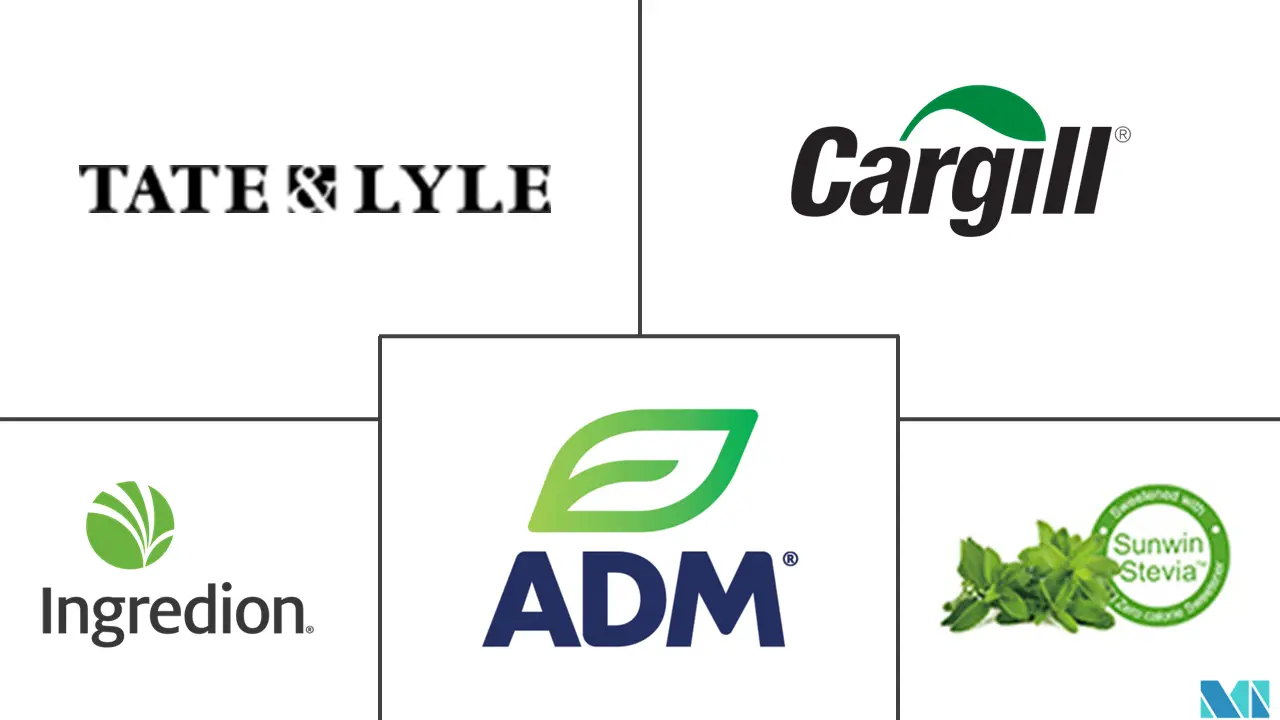Market Size of Natural Sweeteners Industry

| Study Period | 2019 - 2029 |
| Base Year For Estimation | 2023 |
| CAGR | 7.20 % |
| Fastest Growing Market | North America |
| Largest Market | Asia-Pacific |
| Market Concentration | Low |
Major Players
*Disclaimer: Major Players sorted in no particular order |
Natural Sweeteners Market Analysis
The natural sweeteners market is expected to register a CAGR of 7.2% over the next five years.
- Natural Sweeteners are derived from natural ingredients and sources. They are healthier than regular sugar or artificial sweeteners as they are derived from plant-based sources and have low calories. Natural sweeteners do not have any carbohydrates and do not raise blood sugar levels in the body. The demand for no or low-calorie products is increasing as consumers become more aware of their health and food.
- One of the natural sweeteners, stevia, is used in medicinal and food products. Stevia is used for different medicinal uses. It helps with proper gastrointestinal function, kidney function, and many more. In November 2022, PureCircle, an Ingredion Incorporated brand, offered three stevia glycosides from bioconversion ingredients. The ingredients include Reb D, Reb M, and Reb AM. These ingredients can be used in food and beverages.
- Due to the increase in the prevalence of diabetes, obesity, blood pressure, and other chronic diseases, demand for naturally derived ingredients in the products is increasing. According to the Global Health Monitor survey of 2021, Mexico has 52% of Obese people, while 13% of the population in the world is diabetic.
- Additionally, the market for natural sweeteners is growing due to stringent government rules regarding using artificial ingredients in products. The market players are producing different sweeteners according to industrial demand. For instance, Oy Karl Fazer Ab made xylitol from oat nulls in May 2022. Compared to regular sugar, produced xylitol had 40% fewer calories.
Natural Sweeteners Industry Segmentation
Natural Sweeteners are sugar substitutes obtained from natural or organic sources like plants, microbes, and other sources.
The natural sweeteners market is segmented, based on type, into stevia, sorbitol, mannitol, xylitol, erythritol, and other types. Based on application, the market is segmented into dairy, bakery, confectionery, beverages, and other applications. The market is segmented by geography into North America, Europe, Asia-Pacific, South America, and the Middle East and Africa.
For each segment, the market sizing and forecasts have been done based on value (in USD million).
Natural Sweeteners Market Size Summary
The natural sweeteners market is experiencing significant growth, driven by increasing consumer awareness of health and wellness. As people become more conscious of their dietary choices, there is a rising demand for sweeteners derived from natural sources, which are perceived as healthier alternatives to traditional sugar and artificial sweeteners. These natural sweeteners, such as stevia and monk fruit, offer low or zero-calorie options without the adverse effects on blood sugar levels, making them particularly appealing to those managing conditions like diabetes and obesity. The market is further bolstered by stringent government regulations on artificial ingredients, prompting manufacturers to innovate and produce plant-based sweeteners that cater to the growing demand for organic and clean-label products.
The global natural sweeteners market is characterized by its fragmented nature, with both regional and international players vying for market share. Key companies like Tate & Lyle Plc, Archer Daniels Midland Company, and Cargill Incorporated are leading the charge in developing and marketing these ingredients. The market's expansion is supported by strategic mergers and acquisitions, as well as regulatory approvals that facilitate the introduction of new products in various regions. Innovations in production methods, such as the use of ultrasound-assisted fermentation to create xylitol from sugarcane residue, highlight the industry's commitment to sustainability and reducing environmental impact. As the demand for natural sweeteners continues to rise, particularly in regions with aging populations and a growing preference for health-conscious food choices, the market is poised for continued growth over the coming years.
Natural Sweeteners Market Size - Table of Contents
-
1. MARKET DYNAMICS
-
1.1 Market Drivers
-
1.2 Market Restraints
-
1.3 Porter's Five Forces Analysis
-
1.3.1 Threat of New Entrants
-
1.3.2 Bargaining Power of Buyers/Consumers
-
1.3.3 Bargaining Power of Suppliers
-
1.3.4 Threat of Substitute Products
-
1.3.5 Intensity of Competitive Rivalry
-
-
-
2. MARKET SEGMENTATION
-
2.1 Type
-
2.1.1 Stevia
-
2.1.2 Sorbitol
-
2.1.3 Mannitol
-
2.1.4 Xylitol
-
2.1.5 Erythritol
-
2.1.6 Other Natural Sweeteners
-
-
2.2 Application
-
2.2.1 Bakery
-
2.2.2 Confectionary
-
2.2.3 Dairy
-
2.2.4 Beverages
-
2.2.5 Other Applications
-
-
2.3 Geography
-
2.3.1 North America
-
2.3.1.1 United States
-
2.3.1.2 Canada
-
2.3.1.3 Mexico
-
2.3.1.4 Rest of North America
-
-
2.3.2 Europe
-
2.3.2.1 Spain
-
2.3.2.2 United Kingdom
-
2.3.2.3 France
-
2.3.2.4 Germany
-
2.3.2.5 Italy
-
2.3.2.6 Rest of Europe
-
-
2.3.3 Asia-Pacific
-
2.3.3.1 China
-
2.3.3.2 Japan
-
2.3.3.3 India
-
2.3.3.4 Australia
-
2.3.3.5 Rest of Asia-Pacific
-
-
2.3.4 South America
-
2.3.4.1 Brazil
-
2.3.4.2 Argentina
-
2.3.4.3 Rest of South America
-
-
2.3.5 Middle East and Africa
-
2.3.5.1 South Africa
-
2.3.5.2 Saudi Arabia
-
2.3.5.3 Rest of Middle East and Africa
-
-
-
Natural Sweeteners Market Size FAQs
What is the current Natural Sweeteners Market size?
The Natural Sweeteners Market is projected to register a CAGR of 7.20% during the forecast period (2024-2029)
Who are the key players in Natural Sweeteners Market?
Tate & Lyle Plc, Archer Danials Midland Company, Cargill Incorporated, Sunwin Stevia International and Ingredion Incorporated are the major companies operating in the Natural Sweeteners Market.

